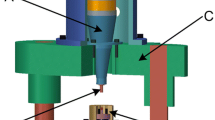Abstract
The authors performed deep punching experiments on PMMA (polymethyl methacrylate) using cylindrical-shaped punches with conical and hemispherical noses. The test samples cracked when no lateral confinement was provided. Application of proper lateral confinement suppressed the cracks. The punching force recorded from the experiments correlates very well with cavity expansion theory. Because the use of a single friction coefficient gives excellent agreement between theory and experiments for two different-shaped punches, the authors propose deep punching as a new technique to measure the friction coefficient.
Similar content being viewed by others
References
Bishop, R.F., Hill, R., andMott, N.F., “The Theory of Indentation and Hardness Tests,”Proc. Phys. Soc.,57,147–159 (1945).
Forrestal, M.J., “Penetration into Dry Porous Rock,”Int. J. Solids Struct.,22,1485–1500 (1986).
Forrestal, M.J., Brar, N.S., andLuk, V.K., “Penetration of Strainhardening Targets with Rigid Spherical-nose Rods,”J. Appl. Mech.,58,7–10 (1991).
Wright, S.C., Huang, Y., andFleck, N.A., “Deep Penetration of Polycarbonate by a Cylindrical Punch,”Mech. Mat.,13,277–284 (1992).
Satapathy, S. andBless, S.J., “Calculation of Penetration Resistance of Brittle Materials Using Spherical Cavity Expansion Analysis,”Mech. Mat.,23,323–330 (1996).
Steinberg, D.J., “Equation of State and Strength Properties of Selected Materials,” Report No. UCRL-MA-106439, Lawrence Livermore National Laboratory (1991).
Lee, J.W. and Satapathy, S., “Comparison of Measured Target Resistance and Predictions from Cavity Expansion Models for Polymethyl Methacrylate,” Report No. IAT.TN 0028, Institute for Advanced Technology, University of Texas at Austin (1994).
Hill, R., The Mathematical Theory of Plasticity, Oxford University Press, London (1950).
Forrestal, M.J., Okajima, K., andLuk, V.K., “Penetration of 6061-T651 Aluminum Targets with Rigid Long Rods,”ASME J. Appl. Mech.,55,755–760 (1988).
Timoshenko, S.P. andGoodier, J.N., Theory of Elasticity, 3rd ed., McGraw-Hill, New York, 406 (1987).
Hope, P.S., Ward, I.M., andGibson, A.G., “The Hydrostatic Extrusion of Polymethylmethacrylate,”J. Mat. Sci.,15,2207–2220 (1980).
Rabinowicz, E., Friction and Wear of Materials, 2nd ed., John Wiley & Sons, New York, 77 (1995).
Author information
Authors and Affiliations
Rights and permissions
About this article
Cite this article
Satapathy, S., Bless, S. Deep punching PMMA. Experimental Mechanics 40, 31–37 (2000). https://doi.org/10.1007/BF02327545
Received:
Revised:
Issue Date:
DOI: https://doi.org/10.1007/BF02327545




